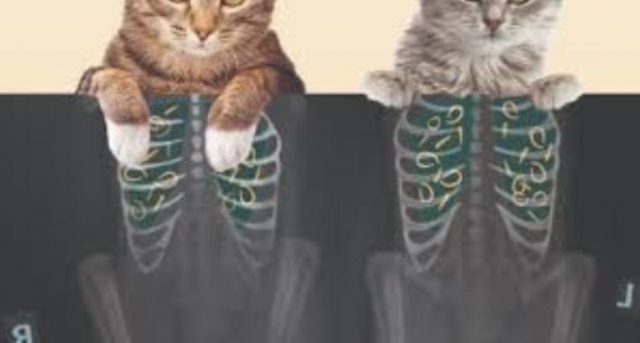Feline lungworms can portend danger for your little furry companion and research has made us understand that these parasitic worms can really travel a distance. They hop from one host to another in search of that perfect burrowing environment and once in a while, one unfortunate kitty serves as a stop for their journey. Although intestinal worms are considered to be more common, lungworms in cats cannot be ignored; continue reading to acquaint yourself with important facts about lungworms, the causes, diagnosis, treatment, and how you can prevent your ball of fur from getting the infection.
Table of Contents
What Are Lungworms?
Lungworms are parasitic organisms that infect, feed on, and reproduce in other living things. A cat gets infected when it ingests the worm, which on getting to the feline’s intestines, enters the bloodstream and from there, gets access to the lungs. This journey can be accomplished in eight or nine days. The worm resides in the lungs until maturity and proceeds to reproduce by laying numerous eggs in both airways and lung tissue.
As the eggs metamorphose into larvae, they move in the direction of the trachea – there, they will be swallowed by the feline who flushed them down its digestive tract. The larvae are expected to exit the kitty’s body through poop from 40 days following the initial infection. While they reside in the lungs, lungworms tend to damage body tissue and cause infection, especially in a cat’s lower respiratory tract. Serious cases of these worms cannot be eliminated via home remedies; you will need the vet’s assistance in treating the infection.
A lungworm is a hair-shaped worm with a body length ranging from one cm to four cm. The males are significantly shorter in length than the females. There are a couple of identified species of this worm that can infect the feline population. Also called feline lungworm, aelurostrongylus abstrusus is the most common among lungworms in cats. The other one infects both cats and canines and is called Eucoleus aerophilous or Capillaria aerophila. Before now, it was not established whether these worms could actually affect kitties; however, recent research has shown that over 5% of all felines carry these worms.
What Are The Causes Of Lungworms In Cats?
Cats don’t need to move far to contact lungworms, so long as they hunt and explore the outdoors, they stand the risk of lungworm infection. Once an environment is hospitable, a full-grown worm can survive up to nine months. Both the Aelurostrongylus abstruse and the Eucoleus aerophilous have their distinctive ways of gaining access to a cat’s body.
The former infects snails and slugs, and the cat, in turn, preys on smaller creatures like rodents, birds, reptiles, and amphibians that eat the infected snails and slugs. The latter majorly infect rodents and earthworms. As the larvae mature inside the host, they emerge to take up residence in small water poodles. Any cat that drinks from these infected water pools will become contaminated, likewise those who prey on infected rodents.
Symptoms To Know If Your Dog Has Lungworms
Many cats can live healthily even though they are infected with lungworm. Most of them tend to show no symptoms at all. Symptoms can only be displayed among felines with a weak immune system, in kittens, or in situations where the infection level is considered extreme. Watch out for the following signals;
- Coughing
- Wheezing
- Shortness of breath
- Mouth breathing
- Tracheitis
- Bronchitis
- Emphysema
- Bacterial pneumonia
- Rapid heart rates
- Nasal discharge
- Lethargy
- No interest in play
- Anorexia
- Depression
- Fever
- Emaciation
Treatment For Lungworm In Cats
Generally, you can eliminate lungworms through prolonged treatment with the right medication. After deciphering your kitty’s specific infection, the vet will recommend the corresponding treatment.
- Deworming Medication
The veterinarian can prescribe deworming medication for your furbaby, depending on the level of infection. To ensure the complete elimination of all worms, the duration of treatment may last as long as two months.
- Antibiotics
Antibiotics are specifically for situations where the cat developed some secondary infections from lungworm. These infections can come in the form of bacterial pneumonia, and the affected cat has to go on antibiotics for two to four weeks.
- Corticosteroids
This is the right medication for any inflammation resulting from lungworm infection. Corticosteroids bring down such swelling when administered according to prescription.
However, if lungworm infestation isn’t the severe type, and the kitty appears to be healthy, the veterinarian may just suggest that you keep the cat under close watch, and allow it to eliminate the worms naturally.
Lungworms In Cats: Is It Contagious And How Do Cats Get It?
For lungworms, there is no evidence of cat-to-cat infections; studies have shown that cats only get infected by eating rodents, birds, amphibians, and reptiles that have preyed on infected snails and slugs. The felines can also get the worms by ingesting water from infested pools.
Diagnosis Of Lungworms In Cats
-

Cats with lungworms source
Arm yourself with your feline companion’s full medical history as that is the first thing the vet will request from you. Following this, the vet will carry out a physical examination, taking note of symptoms that may indicate the presence of lungworms. Lungworm infection can be easily confirmed by getting the poop of a cat tested for larvae. However, we should note that it can take more than one month before the larvae show up; thus, the fecal examination may have to be done several times to be sure.
Some cases of lungworms In Cats may compel the vet to recommend a tracheal wash – this is usually done to fish out any larvae that may have moved to the cat’s trachea from its lungs.
The vet may prefer to do an x-ray to rule out other lung problems, as well as evaluate the condition of the kitty’s lungs. When the vet needs to obtain a visual of the feline’s airways, a bronchoscopy becomes necessary.
More often than not, diagnosis is only made after it becomes clear that the ingestion of antibiotics does not seem to be having any positive effect on the cat’s condition. However, when the ailing cat is a kitten, the vet will have to hasten his diagnosis as these conditions can be life-threatening for younger cats.
Read Also: Covid-19: Does the Coronavirus Affect Animals?
Ways To Prevent Lungworms From Affecting Your Cat
There are quite a few measures you can take to prevent your furball from getting infected. Ensure that your cat gets dewormed as when due. Failure to do so might create an opportunity for the worms to surface.
Try using games to keep the cat exercised and well-stimulated even while indoors. By so doing, the kitty won’t be so inclined to go looking for infected prey to play with. In all, once you take care of your kitty’s deworming needs and keep it away from possible places it can get lungworms, it will go a long way in keeping the health challenge at bay.
